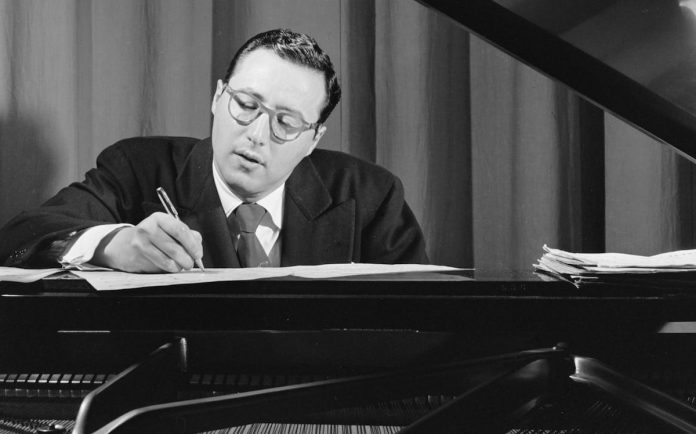Pete Rugolo, master jazz arranger, “learned by trial and error.” Rugolo, born 1915 in Sicily, one-time Stan Kenton alter ego and latterly leading contemporary composer for movies and TV, “just got the sheet music and started to write arrangements.
“Yes, I commenced arranging without any lessons”, Pete told me. “I was playing (piano) with a little band at home in Santa Rosa, California. I used to ask questions of arrangers in the name bands that came to town.”
There were no books on jazz arranging when Pete started, in the early forties. Pete learned by listening to 78 rpm records. “Now, it’s best to go to school”, Pete advised. Later on Pete did go to school with great success. He gained a B.A. in music at San Francisco College and, after studying with Darius Milhaud, he obtained his M.A. at Mills College. “But I never really studied dance music arranging”, he stated.
“To be a good arranger the first requirement is knowing music”, Pete declared. “The better musician you are, the more fluently you can write. You must know harmony and counterpoint thoroughly.”
Pete’s pointers to budding arrangers: have imagination; try things: have courage; be inquisitive; wonder how ‘this’ and ‘that’ would sound together. “For example, think how trumpet and alto sound together. And don’t worry about doubling the seventh.
“These days there are really no rules to follow. You can try almost anything. Today the techniques of instrumentalists have improved so much. You don’t have to worry. You can write almost anything and they will play it.
“Speed in writing is just technique and experience”, Pete declared. “You must have the idea properly in your mind before you start. It really is a gift. Some people figure an arrangement all out in their head and then just write it down. Others seem to take months. The quality of the end result is the thing but, if you have to make a living as an arranger, speed is imperative.”
Pete specially recommended listening to the works of Duke Ellington, Gil Evans, Bill Holman and Gerry Mulligan – Ellington for originality “which is always strictly Ellington”, Evans for tone colour and harmony, Holman for ideas and general swinging and Mulligan for good ensemble sound and melodic and rhythmic ideas. He also suggested that Basie should be studied for “natural swinging” (Neil Hefti’s writing in particular) and Stan Kenton for its individual style. Pete should have added his own name in the latter category with particular emphasis on the Rugolo vocal arranging (for June Christy and others).
“But don’t try to copy anything”, Pete warned. “Try to develop a style where people know it’s you – whether it’s a tone colour or rhythmical pattern or a voicing of the trombones or whatever. Take Gil Evans. You can’t mistake his voicings. You know it’s him immediately.
“Also it’s a question of whether you are an orchestrator, arranger or a composer. You should strive to be a composer. There are people who can only orchestrate. It’s a gift to be able to write a melody. Endeavour to learn to write a melody. Not everyone can, however much they study.”
“Take one little idea (one little ‘gem’) and develop it. Simplicity is the key – knowing what not to put in. It’s so important knowing when not to fill.”
He concluded: “You should never feel you have to set the world on fire in one go. Learn to write a couple of bars and develop them. This comes in studying – learning the principles of composition.”
















